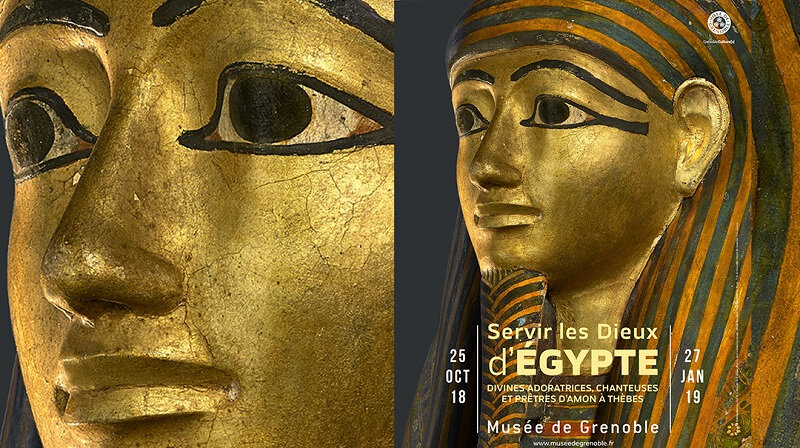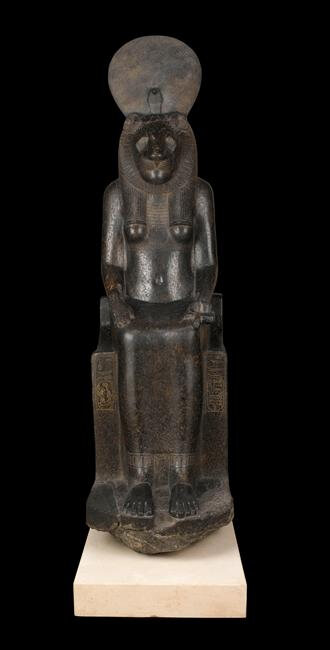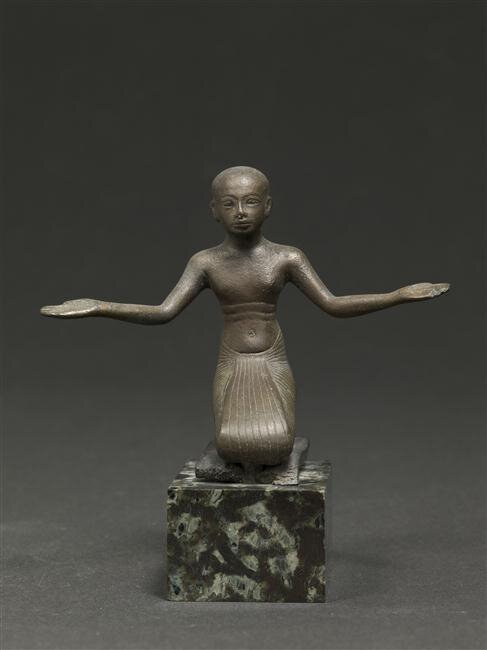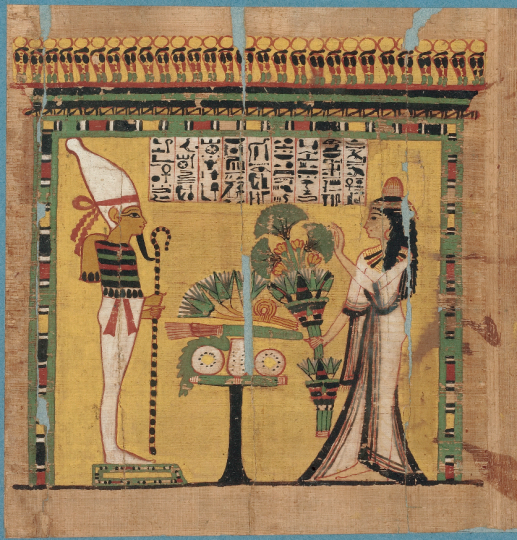"Servir les Dieux d’Egypte" au musée de Grenoble
GRENOBLE.- La rentrée 2018 au musée de Grenoble a été marquée par une exposition événement consacrée à l’Égypte antique, réalisée avec le Louvre. Elle propose une plongée archéologique dans la puissante ville de Thèbes il y a 3000 ans, à travers sa nécropole et le temple monumental d’Amon.
En s’appuyant sur le fonds grenoblois, complété par près de 200 oeuvres du musée du Louvre et d’autres prêts provenant de musées européens, l’exposition introduit les visiteurs au plus près de la société thébaine de la Troisième Période intermédiaire (1069 – 664 av. J.-C). Cette société au service du dieu Amon-Ré dans le temple de Karnak se trouvait durant ces 500 ans au coeur d’enjeux politiques et économiques majeurs. L’exposition met tout particulièrement l’accent sur le rôle important que les femmes y jouaient alors.
Un sujet inédit spécialement imaginé pour Grenoble.
Cercueil anthropoïde de Psamétik, fils de Sbarekhy, Basse Époque, 664-526 av. J.-C. Bois stuqué et peint H. 188 cm ; l. 54 cm ; p. 46 cm, musée de Grenoble, MG 1996 .Don G. de Saint-Ferriol, 1916 (collection du comte L. de Saint-Ferriol) © Ville de Grenoble / Musée de Grenoble - J.-L.Lacroix.
L’exposition s’articule autour de quatre vastes parties qui conduisent le visiteur de part et d’autre du Nil et le fait pénétrer, peu à peu, dans le fonctionnement de la société du temple. La première partie situe au plan géographique et historique Thèbes à la Troisième Période Intermédiaire et permet d’évoquer la spécificité de la collection grenobloise dont une part importante provient de cette ville. La deuxième partie de l’exposition invite les visiteurs sur la rive ouest, dans la nécropole, où furent découvertes des centaines de tombes du clergé masculin et féminin de Karnak, véritable reflet de la société du temps. La troisième partie conduit de l’autre côté du Nil, dans le temple, où les prêtres, suivant une hiérarchie très organisée, occupent des fonctions politiques, administratives et économiques de premier plan soutenues par des activités rituelles fondamentales, garantes de l’ordre du monde autour d’Amon.
Stèle de Padiset, père du dieu Amon-Rê, scribe des rameurs (?), Troisième Période intermédiaire, 22e dynastie, 943- 735 av. J.-C., Thèbes ?. Bois peint. H. 20,8 cm ; l. 15,5 cm ; p. 3,6 cm. Paris, Musée du Louvre, N 3795 Achat, 1826 (collection H. Salt) © Musée du Louvre, Dist. RMN-Grand Palais/Hervé Lewandowski.
Pour l’occasion, le musée de Grenoble investit pleinement ses espaces dédiés aux expositions temporaires, en déborde même, pour offrir un parcours de près de 1500 mètres carrés.
L’ exposition et le colloque international qui sera organisé en janvier 2019 par le musée de Grenoble, le musée du Louvre, Sorbonne Université et la Société française d’égyptologie permettront de faire un point sur la recherche archéologique et mettront en lumière les découvertes récentes qui renouvellent actuellement notre compréhension de la société thébaine.
C’est autour de ces pièces exceptionnelles que le département des Antiquités égyptiennes du musée du Louvre a conçu l’exposition Servir les dieux d’Égypte en collaboration avec le musée de Grenoble. Cette première exposition consacrée à l’égyptologie permettra au musée de donner un éclairage nouveau à sa collection.
GRENOBLE.- The Musée de Grenoble is presenting an exhibition-cum-event devoted to ancient Egypt, organized with the Louvre. It proposes an archaeological plunge into the powerful city of Thebes 3000 years ago, by way of its necropolis and the monumental temple of Amun. Relying on the Grenoble collection, complemented by almost 200 works from the Musée du Louvre and other loans from European museums, the exhibition introduces visitors to the intimate life of Theban society in the Third Intermediate Period (1069 – 664 BCE). That society paying allegiance to the deity Amun-Ra in the temple at Karnak found itself, for those 500 years, at the heart of major political and economic challenges. In particular, the exhibition emphasizes the important role played by women at that time. A novel subject especially devised for Grenoble.
The clergy of Amun, king of the gods of Egypt
The Karnak temple complex, the largest in Egypt, dedicated to the cult of Amun-Ra, king of gods, is situated on the east bank of Thebes. During the Third Intermediate Period (1069-664 BCE), it was an extremely important political hub, a form of religious office countering the power of the Pharaohs, which was then relatively unstable.
In fact, during the 500 years which followed the empire of Ramses, the country was alternately governed from the Delta by dynasties which succeeded one another, or overlapped, then, starting from the south of Sudan, by the Cushite dynasty. In this context, the clergy of Amun appears to be the only long-lasting dynasty, especially in the south of the country. The sovereigns of each dynasty, but also powerful notables, put their daughters at the centre of this religious institution, the famous “Adoratrices of Amun” and their followers, who were singers and musicians. From dynasty to dynasty, these hallowed virgins adopted the daughters of the new ruling sovereigns and thus marked the continuity of power and of the cult of Amun, in which the Pharaoh was the high priest.
The collection of the Musée de Grenoble, starting point of the exhibition
The Egyptian collection of the Musée de Grenoble is one of France’s most important. Grenoble, incidentally, opened its arms to Jean-François and Jacques-Joseph Champollion, the fathers of modern Egyptology.
Twelve coffins and fragments of coffins discovered in the so-called Gourna necropolis in the 19th century (western Thebes), and brought back to France by Comte Louis de Saint-Ferriol in 1842, are among the jewels of the collection. They date from the 10th-7th centuries BCE and belonged either to priests of Amun, or to singers of Amun. It is based on this set of objects that the Department of Egyptian Antiquities at the Musée du Louvre has devised the exhibition in collaboration with the Musée de Grenoble.
Papyrus mythologique de Séramon, chef des recrues du domaine d’Amon et prêtre “prophète” d’Amon, Troisième Période intermédiaire, 21e dynastie, 1069-943 av. J.-C. H. 40,5 cm ; l. 157 cm. Paris, Bibliothèque nationale de France.
The exhibition has been organized in four parts designed to gradually penetrate the way the society of the temple of Karnak functioned. The first part, devoted to “first millennium Thebes rediscovered”, situates Thebes, at the geographical and historical level, in the Third Intermediate Period, and make it possible to describe the specific nature of the Grenoble collection, a major part of which hails from that city. The second part of the exhibition “From Amun to Osiris; priests in the necropolis”, re-situates visitors on the west bank where were found hundreds of tombs of the male and female clergy of Karnak, a veritable reflection of the society of the time. The third part, “The priests in the temple of Amun at Karnak”, takes us to the other side of the Nile into the temple, where the priests, complying with a highly organized hierarchy, held leading political, administrative and economic offices, supported by basic ritual activities, guaranteeing the order of the world around Amun. The fourth and last part, titled “Women in the domain of Amun”, sheds light, thus underpinning very recent studies, on the role of women in the temple, with at their head the adoratrices of the god Amun and their followers, the little known “singers of Amun”. Devoted to the cult of the king of the gods, they also had a special bond with the god Osiris, a renascent and fertile deity, whose chapel has been reconstructed in 3D based on photographs.
La chanteuse de la Résidence d’Amon Méresamon, Troisième Période intermédiaire, 22e dynastie, vers 800 av. J.-C. Bronze. H. 57,5 cm ; l. 13, 5 cm ; p. 12 cm. © SPK/SMB Berlin, Ägyptisches Museum und Papyrussammlung. ÄM 2309.
Statuette d’Isis allaitant Horus dédiée pour Aménardis, Adoratrice du dieu, Troisième Période intermédiaire, 25e dynastie, 710- 678 av. J.-C. Grauwacke H. 23 cm ; l. 7 cm ; p. 17 cm. Paris, Musée du Louvre, N 3991 Achat, 1824 (collection E.-A. Durand) © Musée du Louvre, Dist. RMN-Grand Palais/Georges Poncet.
Statue de Sekhmet dédiée par Amenhotep III et usurpée par Chéchonq Ier, Nouvel Empire, 1391-1353 av. J.-C., et Troisième Période Intermédiaire, 943-922 av. J.-C., Diorite, H. 209 cm ; l. 57 cm ; p. 96 cm. Musée du Louvre, N 7 = A 7 Achat, 1817 (collection du comte de Forbin) © Musée du Louvre, Dist. RMN-Grand Palais/Franck Raux.
Statue de la déesse Mout, Troisième Période intermédiaire, 25e dynastie (?), 743- 655 av. J.-C., Diorite H. 64 cm ; l. 15 cm ; p. 8,5 cm. Paris, Musée du Louvre, E 25456 Achat, 1960 © Musée du Louvre, Dist. RMN-Grand Palais/Georges Poncet.
Donateur agenouillé, Troisième Période intermédiaire, 1069-655 av. J.-C., Bronze, H. 8,5 cm ; l. 11,1 cm ; p. 5,6 cm Paris, Musée du Louvre, E 3188 Achat, 1857 ( collection Giovanni Anastasi) © Musée du Louvre, Dist. RMN-Grand Palais/Christian Décamps.
Vignette initiale du Livre des Morts d’Ankhesenaset, Troisième Période intermédiaire, fin de la 21e dynastie, 1069-943 av. J.-C., Papyrus, H. 22 cm ; L. 22 cm, Paris, Bibliothèque nationale de France, département des manuscrits, BNF Egyptien 62.
Collier à pectoral du grand prêtre et roi Pinedjem Ier, Troisième Période intermédiaire, 21e dynastie, règne de Pinedjem Ier, 1054-1032 av. J.-C., Or et lapis-Lazuli, L. 60 cm. Paris, Musée du Louvre, E 25412 Achat,1956 © Musée du Louvre, Dist. RMN-Grand Palais/Christian Décamps.
Collier à pectoral du grand prêtre et roi Pinedjem Ier, Troisième Période intermédiaire, 21e dynastie, règne de Pinedjem Ier, 1054-1032 av. J.-C. Or et lapis-Lazuli, L. 60 cm. Paris, Musée du Louvre, E 25412 Achat,1956 © Musée du Louvre, Dist. RMN-Grand Palais/Christian Décamps.
Statue du dieu Amon dédiée par Horoudja, Basse Époque, 26e dynastie (?), vers 650 av. J.-C. (?). Bronze incrusté d’or et d’argent, H. 26 cm ; l. 7 cm ; p. 17,8 cm Paris, Musée du Louvre, N 3542. Achat, 1826 (collection H. Salt) © Musée du Louvre, Dist. RMN-Grand Palais/Christian Décamps.
Fond du cercueil de Tanakhtentahat, maîtresse de maison et chanteuse d’Amon, Troisième Période intermédiaire, 21e dynastie, 1069- 943 av. J.-C., Gournah (nécropole thébaine). Bois peint. L. 90 cm ; l. 38 cm ; p. 2,8 cm Musée de Grenoble, MG 1997 Don G. de Saint-Ferriol, 1916 (collection du comte L. de Saint-Ferriol) © Ville de Grenoble / Musée de Grenoble - J.-L.Lacroix.
Sistre de la chanteuse d’Amon et chanteuse d’Isis, Hénouttaouy, Troisième Période intermédiaire, 1069-655 av. J.-C. Bronze noir gravé, autrefois incrusté et plaqué d’or, H. 40 cm ; l. 7,5 cm ; p. 6,1 cm. Paris, Musée du Louvre, E 11201 Achat, 1910 © Musée du Louvre, Dist. RMN-Grand Palais/Christian Décamps.

/https%3A%2F%2Fprofilepics.canalblog.com%2Fprofilepics%2F1%2F0%2F100183.jpg)
/https%3A%2F%2Fstorage.canalblog.com%2F03%2F02%2F119589%2F96711876_o.jpg)
/https%3A%2F%2Fstorage.canalblog.com%2F11%2F31%2F119589%2F94773502_o.jpg)
/https%3A%2F%2Fstorage.canalblog.com%2F20%2F83%2F119589%2F94772815_o.jpg)
/https%3A%2F%2Fstorage.canalblog.com%2F26%2F72%2F119589%2F75604929_o.jpg)
/https%3A%2F%2Fstorage.canalblog.com%2F59%2F60%2F119589%2F26458628_o.jpg)






















/http%3A%2F%2Fstorage.canalblog.com%2F57%2F03%2F119589%2F31415983_o.jpg)
/https%3A%2F%2Fassets.over-blog.com%2Ft%2Fcedistic%2Fcamera.png)
/http%3A%2F%2Fstorage.canalblog.com%2F31%2F49%2F119589%2F111073944_o.jpg)
/http%3A%2F%2Fstorage.canalblog.com%2F64%2F82%2F119589%2F31415376_o.jpg)